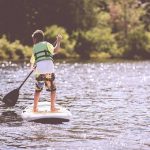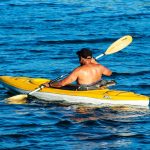The typical response to questions regarding the difficulty of learning to surf is that it is very hard. However, this does not provide those who are curious with a detailed description of how challenging it is and how long the learning process might take.
How long it takes someone to learn to surf is difficult to say because it depends on the person and how much time they are willing to invest. Some people may be able to surf after a few lessons, while others may take longer.
How long does it take to learn to surf?
- 30 minutes: stand up on a learner surfboard in the shallows
- <2 hours: paddle for and catch a whitewater wave
- 30 hours: paddle on your board without falling off
- 60 hours: duck dive under oncoming waves
- 120 hours+: ride along the face of an unbroken or ‘green’ wave
- 150 hours+: ride green waves, paddle out and be competent in the surf
The estimates provided are based on the amount of time you spend surfing with the right board for your level, at a beginner-friendly location, and being in moderate physical condition.
To ride a whitewater wave solo, expect to spend 120-150 hours in the waves. Standing up on a wave in the shallows may only take a couple of waves, but requires significantly more time and effort to ride along the face of a whitewater wave.
There are plenty more things to take into account beyond what has already been mentioned, which we will go over in more detail below.
This will give you a better idea of your own progress and what to expect in terms of Timeline for learner surfer progression.
How Long Does It Take To Learn How To Surf?
How quickly you learn to surf depends on how much time you’re able to dedicate to practicing. Learning to read waves and remain consistent takes much longer.
You can learn the basics of surfing from an instructor in three lessons. With this knowledge, you can begin practicing on your own. However, most experts say it will take a beginner who practices every weekend a year to fully learn how to surf.
Surfing lessons will teach you the basics of the sport, but you will need to practice on your own to improve. Surfing is about more than just being able to stand on a surfboard during a wave.
The Time It Takes To Learn To Surf
Surfing is a satisfying and rewarding sport, and it might be a little tough to learn. You need to master many techniques to move up to being an experienced surfer. This is not a good enough reason to stop trying to learn. It is not too complicated to learn to surf if you begin the right way.
The most important lesson in learning to surf is that you have to be dedicated and put in the time to learn.
There is not one definitive answer to how long it will take to learn how to surf. How quickly someone picks up the sport depends on a number of variables such as the frequency and duration of practice sessions, what kind of equipment is being used, which beach is being surfed at, and the prevailing weather and wave conditions.
Other considerations such as the level of crowding at the beach can also influence the amount of time it takes to learn to surf.
The amount of time it takes to learn to surf varies depending on who you ask and how often you are able to practice. If you are only able to go out on the weekends, it will take longer than if you practice daily or several times a week.
It is possible to learn how to surf, even if you can’t always get away from the waves. You won’t be able to surf the green overnight, but you can learn the basics and be on your way to riding a wave soon.
Choosing The Right Equipment
If you want to make learning to surf easier and faster, get a surfboard that is good for beginners. If you use a board that is not meant for beginners, you will spend more time struggling than actually surfing.
Longboards are good for beginners because they are stable, long, wide, and buoyant. Learning on the right board helps you develop good technique from the start. Using the right board for beginners also lets you catch the next wave quickly instead of struggling or not being able to move fast enough.
The amount of water that a surfboard displaces weighs more than the surfboard itself. That is what provides the buoyancy necessary for the surfboard to float. A surfboard of greater volume will have more buoyancy and will be able to glide more smoothly.
The surfer will also be able to balance better on a board with more buoyancy.
When choosing your first board, you need to take your weight into account. The amount of volume you need increases with your weight. To find the number of liters you need, divide your weight by the volume of the board.
The volume of a surfboard affects its buoyancy and stability, with a higher volume providing more flotation. The width and length of a surfboard also affect stability, which is important for beginners.
A wider and longer board also allows beginners to learn foot placement and pop-ups more easily.
Longboards have a small or nonexistent rocker, which makes them easy to glide across the water. This is perfect for beginners, as a smaller rocker makes the board more maneuverable.
Choosing a surfboard to learn on is generally advised to be three feet longer than the person surfing. A board this size will allow the person to be able to surf comfortably on the waves.
How Often Practice Will Be
If you’ve been taught by an Instructor and done well, you’re not a full-fledged surfer yet. It’s one thing to surf with an instructor, and a different experience to surf by yourself.
Your instructor will find the best surf conditions, the best day, the safest part of the beach, and even the waves you will learn on. The instructor knows the dangers to avoid and the important surfing etiquette while on the beach with others.
When you go surfing alone, it will seem much more complicated than it did with your instructor.
Although you will be successful if you go solo, it will take more time and effort. Even professional surfers are always learning and trying to improve their skills.
You will improve at surfing more quickly if you go to the beach often. Whenever it is safe, try to take advantage of opportunities to surf.
Stages of Learning to Surf: Basics
The key take away from this text is that there are different levels of ability when it comes to surfing, and it takes different amounts of time for different people to learn each level.
Riding Whitewater Waves in the Shallows (First-Timer)
If you are just starting to surf, the first thing you will want to do is ride the waves in the shallows. These waves break in water that is knee to chest-deep, which makes them a good option for beginners.
The first waves you’ll encounter when you try to go surfing will be these waves.
If your surfboard is big and soft, about 2 feet longer than your height, you will be able to catch a few waves and ride them with a few tries.
It is rarely easy to stand up on a surfboard for beginners, however it is manageable on the correct board.
This is the type of wave that is typically taught to students in surf schools because it is optimal for learning.
Riding Whitewater Waves Further Out (Beginner)
If you keep practicing, you’ll eventually want to try riding waves that are further from the shore.
You will be able to do almost all of the functional aspects of surfing once you have gained more confidence in the sea. This includes paddling, sitting up on your board, duck diving, and standing up.
Paddling
It is much harder to paddle a surfboard than it seems. Surfboards are unsteady in the water and it can be difficult to become accustomed to them.
The sea is constantly moving, so you’ll need to paddle in lots of different directions to avoid oncoming waves and other surfers.
In order to catch a wave, you will need to be able to paddle in the opposite direction of the wave. This can take some practice.
Although it varies depending on the person, it will usually take anywhere from 20 to 50 hours in the surf before they can paddle confidently on a surfboard.
When deciding on a surfboard, remember that a bigger board will be easier to paddle. If you’re having trouble paddling, keep practicing in shallower water until it gets easier.
Sitting Up on Your Surfboard
Sitting up on a surfboard is not as easy as it sounds.
The act of sitting up on a surfboard provides respite for the chest and lungs, which can become quite tired and uncomfortable from all the paddling, particularly in the early stages.
Sitting up will also give you a better view of the waves so you can see them coming more clearly.
Learning to paddle and stand up on your board is the easy part of surfing that will take 50-80 hours to learn properly. It is much harder to learn on a smaller board, so take that into account if you are trying to learn to surf on a board that is smaller than recommended.
The point of this is to get a surfboard that is the right size for your height and weight. If you need more information, read my beginner surfboard guide.
Duck Diving
Duck diving is a term used to describe what surfers do to get under an oncoming wave that has already broken.
The surfers duck under the waves to avoid being hit by them.
A duck dive is an important part of surfing where you go underwater to avoid a wave that’s about to hit you. If you don’t duck dive, the wave will push you back to the shore.
You can expect to spend about 50 hours practicing surfing before you are able to duck dive properly. This is because it is a technique that involves balance, timing, and paddling skills.
It is also almost impossible to duck dive with some of the bigger learner surfboards, so you will need to consider doing an Eskimo roll instead if you are on a longboard or thick foam board.
Note on the Fundamentals of Surfing
The points above may look and sound easy, but they are not easy to execute when you are out in the sea with waves and other people around.
When learning to surf, it will take some time to master the basics near the shore.
Attempting to paddle out and surf on big waves before you are prepared is dangerous not only for yourself but also for other people in the water.
If you do not feel confident doing all of the points above, it is likely that you will be a danger to yourself and others while surfing.
The reason for this is that these basics assist you in not only finding the best waves, but also controlling your surfboard to avoid accidents.




